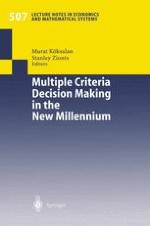This volume contains a collection of papers presented at the 15th International Conference on Multiple Criteria Decision Making held in Ankara, Turkey July 10 14, 2000. This was one of the regular conferences of the International Society on Multiple Criteria Decision Making, which are held at approximately two-year intervals. The Ankara conference had 195 participants from 38 countries. A total of 185 papers were presented at the conference. The title of our volume is MCDM in the New Millennium. The papers presented at the conference reflect the theme. We had several papers on information technology (IT) and many application papers. Of the 81 application papers presented, 14 appear in the volume. We expect more IT applications of MCDM to appear in the future, in particular in the areas of e-commerce and the internet. The conference surroundings and accomodations were excellent, and conducive to both an outstanding academic exchange, and enjoyment and a cultural broadening of participants. We had a pleasant and enjoyable outing and visit to the Anatolian Civilizations Museum. We also had an outstanding banquet at which awards were presented. The MCDM Gold Medal was presented to Professor Thomas Saaty, of the University of Pittsburgh. The MCDM Presidential Service Award was presented to ProfessorPekka Korhonen of the Helsinki School of Economics for his years of presidential service to the society. The society presented the MCDM Edgeworth-Pareto Award to Professor Alexander V. Lotov of the Russian Academy of Sciences.
